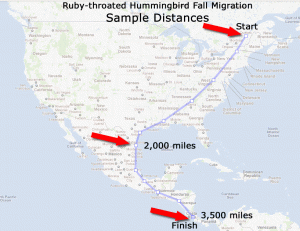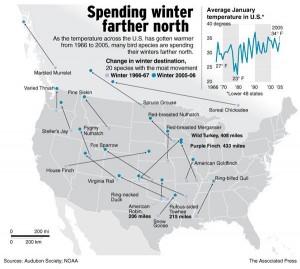The seasons of spring and autumn are seasons of transition in the mid-latitudes – they hold onto memories of the season before while providing glimpses of the season to come. Recently, the Northern Hemisphere transitioned into meteorological fall, including the months of September, October, and November. As September begins, daytime high temperatures remember summer’s warmth, yet a few weeks to months later are dramatically different. Mornings spent with a slight chill in the air soon require additional layers to prevent the cold. These transitions can happen over a few short weeks or extend through the months.
It is the change to these transitions, such as the average date of first frost, that are an important key to understanding a changing climate. Even small changes can have a large effect on migrating birds. The date of first or last frost can prompt birds to begin their flight patterns either too early or too late, which puts their survival at risk. The Ruby-throated Hummingbird (Archilochus colubris), for example, may be prompted to migrate later due to temperatures remaining warm late into autumn. However, as they migrate, they may encounter colder weather due to a transitioning Arctic weather system. If they left their summering location at their normal time, they would avoid these extreme weather events. You can see the normal migration pattern of the Ruby-throated Hummingbird in the map below.

Image from Journey North, depicting the migratory route of the Ruby-throated Hummingbird. Finish is their wintering location in Costa Rica
This idea is further supported in the following map, which was produced by the Audubon Society and NOAA which shows that migrating birds are spending their winters farther north due to warming temperatures. The light blue dots symbolize the general location each species wintered in 1966-1967. The dark blue dots connected by the line represent where the species wintered in 2005-2006.

Map showing changes in wintering location for various bird species from 1966-67 to 2005-06. From Audubon Society and NOAA
In some cases, these birds are more than 650 km from their 1966-1967 wintering location. In addition to putting the birds in the path of transitioning weather patterns, dramatic shifts like these can upset the delicate balance of local ecosystems; insects and plants that these birds naturally prey on may quickly become over-populated if the migrating birds are wintering elsewhere. An example of this can be seen in the Elementary GLOBE book, “The Mystery of the Missing Hummingbirds.”
As we venture further into autumn in the Northern Hemisphere and spring in the Southern Hemisphere, it is important to keep an eye to our GLOBE instruments to monitor the changes that are affecting not only birds, but plants and other creatures that rely on weather changes for their survival.
You, as a GLOBE student, are given a unique opportunity to collect and submit data that can be used to study the transition seasons. Students in the Kingdom of Bahrain are already examining this change in order to understand how the birds are adapting to their changing climate. Be sure to start performing basic protocols, such as air temperature, precipitation and soil temperature, and add in other phenological protocols, such as Ruby-throated Hummingbird observations, arctic bird migration and green up or green down, to monitor these important transition season events. And be sure to let us know about your research as it develops. These activities also help students understand the Next Generation Science Standards of Crosscutting Concepts, such as “Cause and Effect” and “Systems and System Models,” found in the progression of Earth Systems Science.

I like the idea
Audubon Society and NOAA do great work. Climate change is always in debate and more scientific information would be appreciated.
An eyeopener in terms of how a Misuse of the Environment effects other Living Organism Especially the Birds.
Thank you for the wonderful Insite.
The transition seasons, People get sick very much